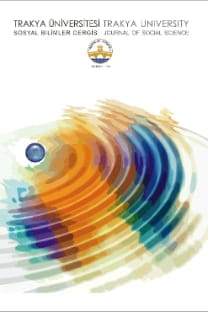Union of economics with geography based on the concept of location: A historical perspective
İktisat ile coğrafya bilimlerinin mekan kavramı üzerine birleşmeleri: Tarihsel bir yaklaşım
___
- Bodin, Jean, Les Six livres de la République (The Six Books of the Commonwealth), 1576.
- Botero, Giovanni, Della ragione di Stato (The Reason of State), 1589.
- Chamberlin, Edward Hastings, 1933. The Theory of Monopolistic Competition. Harvard University Press, Cambridge, MA
- Chou, Exploring Spatial Analysis in Geographic Information Systems. Onword Press, 1997.
- Christaller, Walter, Die Zentralen Orte in Süddeutschland (Central Places in Southern Germany), Prentice-Hall, Englewood Cliffs, NJ, 1933.
- Cliff, Andrew David and Ord, John Keith, Spatial Autocorrelation, Pion, London, 1973.
- Dixit, Avinash K. and Stiglitz, Joseph Eugene, ―Monopolistic Competition and Optimum Product Diversity‖. American Economic Review, 67, p.297-308, 1977.
- Fujita, Krugman and Venables, The Spatial Economy: Cities, Regions and International Trade. MIT Press, 2000.
- Gottdiener, Mark, The Social Production of Urban Space. University of Texas Press, 1985.
- Hagerstrand, Torsten, Innovation Diffusion as a Spatial Process. University of Chicago Press, 1967.
- Haggett, Peter, The Geographer‘s Art. Blackwell, 1989.
- Haggett, Cliff and Frey, Location Analysis in Human Geography. Edward Arnold, 1977.
- Hakewill, George, Apologie ... of the Power and Providence of God, 1627.
- Hartshorne, Richard, The Nature of Geography. Association of American Geographers, 1939.
- Harvey, David, "The problem of Theory Construction in Geography". Journal of Regional Science 7, 211-216, 1967.
- Hempel, Carl Gustav, Aspects of Scientific Explanation, 1967.
- Isard, Walter, Location and Space-economy; a General Theory Relating to Industrial Location, Market Areas, Land Use, Trade, and Urban Structure. Cambridge: Published jointly by the Technology Press of Massachusetts Institute of Technology and Wiley, 1956.
- Johnston, Ronald John, The Future of Geography. Methuen, 1985.
- Johnston, Ronald John, Geography and Geographers, Anglo- American Human Geography Since 1945. Arnold, 1997.
- Kuhn, Thomas, The Structure of Scientific Revolutions. University of Chicago Press, 1962.
- Krugman, Paul, Geography and Trade. Cambridge, MIT Press, 1991.
- Krugman, Paul, Development, Geography, and Economic Theory. MIT Press, 1997.
- Krugman, Paul, "The New Economic Geography, Now Middle-Aged ". Prepared for presentation to the Association of American Geographers, Washington, D.C., 2010.
- Lefebvre, Henri, The Production of Space. Blackwell, 1991.
- Lloyd and Dicken, Location in Space: A Theoretical Approach to Economic Geography. Harper & Row, 1977.
- Lösch, August, The Economics of Location, 1954.
- Ray, John, The Wisdom of God, 1691.
- Soja, Postmodern Geographies: The Reassertion of Space in Critical Social Theory. Verso, 1989.
- Steward, John Q., Demographic Gravitation: Evidence and Applications, 1948.
- Tuan, Yi-Fu, "Humanistic Geography". Annals of the Association of American Geographers, 66, 266-276, 1976.
- Tuan, Yi-Fu, Space and Place. University of Minnesota, 1977.
- Webber, Impact of Uncertainty on Location. MIT Press, 1972.
- Weber, Alfred, Über den Standort der Industrie (Theory of the Location of Industries), 1909.
- Wilson and Bennett, Mathematical Methods in Human Geography and Planning. John Wiley and Sons, 1985.
- Zeiler, Michael, Modeling Our World. Environmental Systems Research Institute, 1999.
- ISSN: 1305-7766
- Yayın Aralığı: 2
- Başlangıç: 2000
- Yayıncı: Trakya Üniversitesi Sosyal Bilimler Enstitüsü
İngilizceyi yabancı dil olarak öğrenmekte olan üst seviyedeki sınıflarda roman öğretimi
Creative writting of students with computer in German as a foreign language course
KREATIVES SCHREIBEN DER STUDENTEN IM DAF-UNTERRICHT MIT HILFE DES COMPUTERS
ÇEVİRİBİLİM TARTIŞMALARI GÖLGESİNDE ÇEVİRİ ÖĞRETİMİ VE ÇEVİRİ DİDAKTİĞİ GEREKSİNİMİ
ORTAÖĞRETİMDE ÖĞRENCİ BAŞARISINDA AİLENİN ROLÜ
Adam Smith'in ekonomik kriz görüşü: South Sea Balonu
Engin DEMİREL, AHMET ATAKISI, Gökhan SÖNMEZLER
MESLEK YÜKSEKOKULLARININ YEREL EKONOMİYE KATKILARI: BABAESKİ MESLEK YÜKSEKOKULU ÖRNEĞİ
ÖZEL SERMAYELİ MEVDUAT BANKALARI PERSONEL ve ŞUBE SAYILARI: PANEL VERİ MODELİ YAKLAŞIMI
